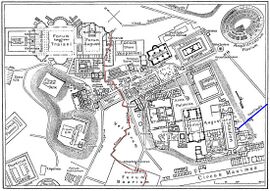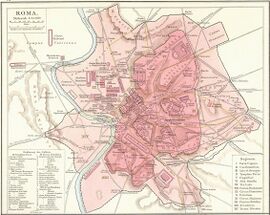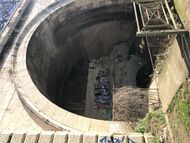Engineering:Cloaca Maxima
 A map of central Rome during the time of the Roman Empire, showing the Cloaca Maxima in red | |
| <mapframe zoom="13" frameless="1" align="center" longitude="12.4848" latitude="41.8957" height="200" width="270">{"type":"Feature","geometry":{"coordinates":[12.4848,41.8957],"type":"Point"},"properties":{"marker-color":"#5E74F3","title":"Cloaca Maxima","marker-symbol":"monument"}}</mapframe> Click on the map for a fullscreen view | |
| Coordinates | [ ⚑ ] : 41°53′45″N 12°29′05″E / 41.8957°N 12.4848°E |
|---|---|
The Cloaca Maxima[n 1] (Latin: Cloāca Maxima, lit. Greatest Sewer) was one of the world's earliest sewage systems. Its name is related to that of Cloacina, a Roman goddess.[1] Built during either the Roman Kingdom or early Roman Republic, it was constructed in Ancient Rome in order to drain local marshes and remove waste from the city. It carried effluent to the River Tiber, which ran beside the city. The sewer started at the Forum Augustum and ended at the Ponte Rotto and Ponte Palatino. It began as an open air canal, but it developed into a much larger sewer over the course of time. Agrippa renovated and reconstructed much of the sewer. This would not be the only development in the sewers. By the first century CE all eleven Roman aqueducts were connected to the sewer. After the Roman Empire fell the sewer still was used. By the 19th century, it became a tourist attraction. Some parts of the sewer are still used today. Whilst still being used, it was highly valued as a sacred symbol of Roman culture, and Roman engineering.
Construction and history
According to tradition, it may have initially been constructed around 600 BC under the orders of the king of Rome, Tarquinius Priscus.[2][3] He ordered Etruscan workers and the plebeians to construct the sewers.[4] Before constructing the Cloaca Maxima, Priscus, and his son Tarquinius Superbus, worked to transform the land by the Roman forum from a swamp into a solid building ground, thus reclaiming the Velabrum.[5][6][7] In order to achieve this, they filled it up with 10-20,000 cubic meters of soil, gravel, and debris.[8][9][10]
At the beginning of the sewer's life it consisted of open-air channels lined up with bricks centered around a main pipe.[11][12] At this stage it might have had no roof. However, wooden holes spread throughout the sewer indicate that wooden bridges may have been built over it, which possibly functioned as a roof. Alternatively, the holes could have functioned as a support for the scaffolding needed to construct the sewer.[13] The Cloaca Maxima may also have originally been an open drain, formed from streams originating from three of the neighboring hills, that were channeled through the main Forum and then on to the Tiber.[3] As building space within the city became more valuable, the drain was gradually built over.[citation needed]
By the time of the late Roman Republic this sewer became the city's main storm drain.[14] It developed into a system 1,600 meters long.[15] By the time of the Second Century BCE it had a 101 meter long canal that was covered up and expanded into a sewer.[16][17][18] Pliny the Elder, writing in the late 1st century, describes the early Cloaca Maxima as "large enough to allow the passage of a wagon loaded with hay."[19] Eventually, the sewer could not continue growing to keep up with the expanding city. Romans would discard waste through other openings rather than the sewers.[12] From 31 BCE to 192 CE manholes could be used to access the sewer, which could be traversed by canal at this point. Manholes were decorated with marble reliefs, and canals were made of Roman concrete and flint.[20]
The eleven aqueducts which supplied water to Rome by the 1st century AD were finally channeled into the sewers after having supplied many of the public baths such as the Baths of Diocletian and the Baths of Trajan, as well as the public fountains, imperial palaces and private houses.[21][22] The continuous supply of running water helped to remove wastes and keep the sewers clear of obstructions. The best waters were reserved for potable drinking supplies, and the second quality waters would be used by the baths, the outfalls of which connected to the sewer network under the streets of the city.[23][24] The Cloaca Maxima was well maintained throughout the life of the Roman Empire and even today drains rainwater and debris from the center of town, below the ancient Forum, Velabrum, and the Forum Boarium. In more recent times, the remaining passages have been connected to the modern-day sewage system, mainly to cope with problems of backwash from the river.[citation needed]
After the fall of the Roman empire the Cloaca Maxima continued to be used. In the 1600s the Cardinal Chamberlain imposed a tax on residents of Rome in order to pay for the upkeep of the sewer.[13] By the time of the 1800s the Cloaca Maxima became popular as a tourist attraction. From 1842 to 1852 sections of the sewer were drained. Pietro Narducci, an Italian engineer was hired by the city of Rome to survey and restore the parts of the sewer by the Forum and the Torre dei Conti in 1862. In 1890 Otto Ludwig Richter, a German archaeologist created a map of the sewers.[25] These efforts renewed public interest in sanitation.[13]
Route
The Cloaca Maxima started at the Forum Augustum and followed the natural course of the suburbs of ancient Rome, which led between the Qurinal, Viminal, and Esquilline Hills. It also passed by the Forum of Nerva, the Arch of Janus, the Forum Boarium, the Basilica Aemilia, and the Forum Romanum, ending at the Velabrum.[26] The sewer's outfall was by the Ponte Rotto and Ponte Palatino. Some of this is still visible today.[20][27] The branches of the main sewer all appear to be 'official' drains that would have served public toilets, bathhouses and other public buildings. Private residences in Rome, even of the rich, would have relied on some sort of cess-pit arrangement for sewage.[citation needed]
Significance and effects
Dionysius of Halicarnassus, Ant. Rom. 3.67.5[28]
The Cloaca Maxima was large enough for "wagons loaded with hay to pass" according to Strabo. It could transport one million pounds of waste, water, and unwanted goods, which were dumped into the streets, swamps, and rivers near Rome. They were all carried out to the Tiber River by the sewer. It used gutters to collect rainwater, rubbish, and spillage, and conduits to dispense up to ten cubic meters of water per second.[13][29] Vaults were closed with flat panels or rocks were used in the construction. This sewer used a trench wall to hold back sediments.[9]
Some of its water was still polluted, contaminating water many depended on for irrigation, swimming, bathing, and drinking.[14][30] The sewer reduced the number of mosquitos, thereby limiting the spread of malaria by draining marshy areas.[31] Animals, including rats, could find their way into the sewer.[15]
The Cloaca Maxima was a highly valued feat of engineering. It may have even been sacrosanct. Since the Romans viewed the movement of water to be sacred, the Cloaca Maxima may have had a religious significance. Aside from religious significance, the Cloaca Maxima may have been praised due to its age and its demonstration of engineering prowess.[32][33] Livy describes the sewer as:
Works for which the new splendor of these days has scarcely been able to produce a match.— Titus Livius, Titus Livius, The History of Rome, Book 1
The writer Pliny the Elder describes the Cloaca Maxima as an engineering marvel due to its ability to withstand floods of filthy waters for centuries. Cassiodorus, a Roman senator and scholar, praised the sewage system in Variae. The Cloaca Maxima was a symbol of Roman civilization, and its superiority to others.[34][35] Roman authors were not the only people to praise the Cloaca Maxima. British writer Henry James stated that it gave him: "the deepest and grimmest impression of antiquity I have ever received."
The system of Roman sewers was much imitated throughout the Roman Empire, especially when combined with copious supplies of water from Roman aqueducts. The sewer system in Eboracum—the modern-day English city of York—was especially impressive and part of it still survives.[36]
See also
- Roman aqueduct
- Barrel vault
- List of Roman aqueducts by date
- Sanitation in ancient Rome
Notes
- ↑ Less often, Maxima Cloaca. la-x-classic
References
- ↑ Narducci, Pietro (1889) (in it). Sulla fognatura della città di Roma: descrizione tecnica. Forzani. https://books.google.com/books?id=CBoXAAAAYAAJ&q=Cloaca.
- ↑ Taylor, Rabun; Rinne, Katherine. Rome: an Urban History from Antiquity to the Present, by Rabun Taylor, Katherine Rinne, and Spiro Kostof (d), (Cambridge University Press: September 2016).. pp. 8–9. https://www.academia.edu/27371471.
- ↑ 3.0 3.1 "Waters of Rome Journal - 4 - Hopkins.indd". http://www.iath.virginia.edu/rome/Journal4Hopkins.pdf.
- ↑ "Titus Livius (Livy), The History of Rome, Book 1, chapter 56". https://www.perseus.tufts.edu/hopper/text?doc=Perseus:text:1999.02.0151:book=1:chapter=56.
- ↑ Landart, Paula (2021). Finding Ancient Rome: Walks in the city. Paula Landart. pp. 49.
- ↑ Hunt, Alisa (2016). Reviving Roman Religion: Sacred Trees in the Roman World. Cambridge University Press. pp. 101. ISBN 978-110-715-354-7.
- ↑ Littlewood, R. Joy (2006). A commentary on Ovid: Fasti book VI. OUP Oxford. pp. 124. ISBN 978-019-927-134-4.
- ↑ Izzet, Vedia (2007). The Archaeology of Etruscan Society. Cambridge University Press. pp. 228. ISBN 978-110-732-091-8.
- ↑ 9.0 9.1 Garrett, Bradley; Galviz, Carlos; Dobraszczyk, Paul (2016). Global Undergrounds: Exploring Cities Within. Reaktion Books. ISBN 978-178-023-611-7.
- ↑ Viollet, Pierre-Louis (2017). Water Engineering in Ancient Civilizations: 5,000 Years of History. CRC Press. pp. 129. ISBN 978-020-337-531-0.
- ↑ Mehta-Jones, Shilpa (2005) (in en). Life in Ancient Rome. Crabtree Publishing Company. pp. 28. ISBN 978-0-7787-2034-8. https://books.google.com/books?id=cAZ1793YuyIC&dq=Cloaca+maxima&pg=PA28.
- ↑ 12.0 12.1 Zimring, Carl; Rathje, William (2012). Encyclopedia of Consumption and Waste: The Social Science of Garbage. SAGE Publications. pp. 802. ISBN 978-145-226-667-1.
- ↑ 13.0 13.1 13.2 13.3 Bianchi, Elisabetta. “Projecting and Building the Cloaca Maxima.” in E. Tamburrino (a cura di), Aquam Ducere II. Proceedings of the second international summer school “Water and the City: Hydraulic systems in the Roman Age” (Feltre, 24th-28th August 2015), Seren del Grappa (BL), 2018, pp. 177-204. (2018): n. pag. Print.
- ↑ 14.0 14.1 RAUTANEN, SANNA-LEENA, et al. “Sanitation, Water and Health.” Environment and History, vol. 16, no. 2, White Horse Press, 2010, pp. 173–94,
- ↑ 15.0 15.1 Aldrete, Gregory S. (2004) (in en). Daily Life in the Roman City: Rome, Pompeii and Ostia. Greenwood Publishing Group. pp. 15, 34-35, 97. ISBN 978-0-313-33174-9. https://books.google.com/books?id=40AjSfdJXaAC&dq=Cloaca+maxima&pg=PA35.
- ↑ Hopkins, John N. N. "The Cloaca Maxima and the Monumental Manipulation of water in Archaic Rome". Institute of the Advanced Technology in the Humanities. Web. 4/8/12
- ↑ Livy, Ab urbe condita, 1.56
- ↑ "RomaSegreta.it – Cloaca Maxima" (in it-IT). 2013-05-12. https://www.romasegreta.it/ripa/cloaca-maxima.html.
- ↑ Plinius Secundus, Gaius, 23-79. (2014). Natural history.. Harvard University Press. OCLC 967702213. http://worldcat.org/oclc/967702213.
- ↑ 20.0 20.1 Malacrino, Carmelo G. (2010) (in en). Constructing the Ancient World: Architectural Techniques of the Greeks and Romans. Getty Publications. pp. 172–173. ISBN 978-1-60606-016-2. https://books.google.com/books?id=5Gfk34wJ8-kC&dq=Cloaca+maxima&pg=PA174.
- ↑ Woods, Michael (2000). Ancient medicine: from sorcery to surgery. Twenty-First Century Books. ISBN:978-0-8225-2992-7, p.81.
- ↑ Lançon, Bertrand (2000). Rome in late antiquity: everyday life and urban change, AD 312-609. Routledge. ISBN:978-0-415-92975-2, p.13.
- ↑ Herodian, Roman History, 5.8.9
- ↑ "BBC Religion & Ethics - Exploring Rome's 'sacred sewers'". http://www.bbc.co.uk/religion/0/20627618.
- ↑ Ebbo Demant: Vom Schleicher zum Springer. Hans Zehrer als politischer Publizist. Mainz 1971, S. 9.
- ↑ "Cloaca Massima". http://www.romacittaeterna.it/cloaca_massima-1.html.
- ↑ "Eutropius, Abridgment of Roman History (Historiae Romanae Breviarium)". https://tertullian.org/fathers/eutropius_breviarium_2_text.htm.
- ↑ Quilici, Lorenzo (2008): "Land Transport, Part 1: Roads and Bridges", in: Oleson, John Peter (ed.): The Oxford Handbook of Engineering and Technology in the Classical World, Oxford University Press, New York, ISBN:978-0-19-518731-1, pp. 551–579 (552)
- ↑ Eslamian, Saeid (2018). Handbook of Engineering Hydrology. CRC Press. pp. 186. ISBN 9781466552364. https://books.google.com/books?id=I2G1DwAAQBAJ.
- ↑ Zeldovich, Lina (2021-11-19) (in en). The Other Dark Matter: The Science and Business of Turning Waste into Wealth and Health. University of Chicago Press. pp. 22–23. ISBN 978-0-226-81422-3. https://books.google.com/books?id=l2pCEAAAQBAJ&q=History+of+Roman+Sewers.
- ↑ Butler, David; Digman, Chris; Makropoulos, Christos; Davies, John (2018). Urban Drainage. CRC Press. ISBN 978-149-875-061-5.
- ↑ Magnusson, Roberta J. (2012). "Katherine Wentworth Rinne . The Waters of Rome: Aqueducts, Fountains, and the Birth of the Baroque City . New Haven: Yale University Press. 2010. Pp. X, 262. $65.00.". The American Historical Review 117 (3): 954–955. doi:10.1086/ahr.117.3.954.
- ↑ "Roman antiquities 3". https://www.the-romans.eu/books/Roman-antiquities-3.php#60.
- ↑ Bradley, Mark (2012-07-26) (in en). Rome, Pollution and Propriety: Dirt, Disease and Hygiene in the Eternal City from Antiquity to Modernity. Cambridge University Press. pp. 81–105. ISBN 978-1-139-53657-8. https://books.google.com/books?id=rrAgAwAAQBAJ&dq=Cloaca+Maxima+religion&pg=PA81.
- ↑ Laporte, Dominique (2002-02-22) (in en). History of Shit. MIT Press. pp. 13-15, 47, 78. ISBN 978-0-262-62160-1. https://books.google.com/books?id=BWsnWlfq4jcC&q=Cloaca+maxima.
- ↑ Darvill, Timothy, Stamper, Paul and Timby, Jane (2002). England: an Oxford archaeological guide to sites from earliest times to AD 1600. Oxford University Press. ISBN:978-0-19-284101-8, pp. 162-163.
External links
- Cloaca Maxima: article in Platner's Topographical Dictionary of Ancient Rome
- Pictures taken from inside the Cloaca Maxima
- Aquae Urbis Romae: The Waters of the City of Rome, Katherine W. Rinne
- The Waters of Rome: "The Cloaca Maxima and the Monumental Manipulation of Water in Archaic Rome" by John N. N. Hopkins
- Rome: Cloaca Maxima
- Lucentini, M. (31 December 2012). The Rome Guide: Step by Step through History's Greatest City. Interlink. ISBN 9781623710088. https://books.google.com/books?id=laMDAQAAQBAJ.
| Preceded by Aqua Claudia |
Landmarks of Rome | Succeeded by Baths of Agrippa |
ro:Canalizarea Romei antice#Sistemul Cloaca Maxima
 |




